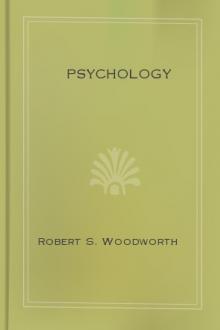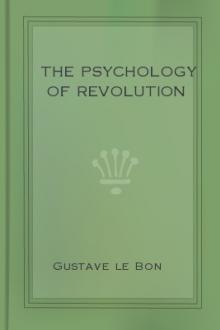The Psychology of Beauty by Ethel D. Puffer (good non fiction books to read TXT) 📕

- Author: Ethel D. Puffer
- Performer: -
Book online «The Psychology of Beauty by Ethel D. Puffer (good non fiction books to read TXT) 📕». Author Ethel D. Puffer
But the sensuous beauty of art does not exhaust the aesthetic experience. What of the special emotions—the gayety or triumph, the sadness or peace or agitation—that hang about the work of art, and make, for many, the greater part of their delight in it? Those among these special emotions which belong to the subject-matter of a work—like our horror at the picture of an execution—need not here be discussed. To understand the rest we may venture for a moment into the realm of pure psychology. We are told by psychology that emotion is dependent on the organic excitations of any given idea. Thus fear at the sight of a bear is only the reverberation in consciousness of all nervous and vascular changes set up instinctively as a preparation for flight. Think away our bodily feelings, and we think away fear, too. And set up the bodily changes and the feeling of them, and we have the emotion that belongs to them even without the idea, as we may see in the unmotived panics that sometimes accompany certain heart disturbances. The same thing, on another level, is a familiar experience. A glass of wine makes merriment, simply by bringing about those organic states which are felt emotionally as cheerfulness. Now the application of all this to aesthetics is clear. All these tensions, relaxations,—bodily “imitations” of the form,—have each the emotional tone which belongs to it. And so if the music of a Strauss waltz makes us gay, and Handel’s Largo serious, it is not because we are reminded of the ballroom or of the cathedral, but because the physical response to the stimulus of the music is itself the basis of the emotion.
What makes the sense of peace in the atmosphere of the Low Countries? Only the tendency, on following those level lines of landscape, to assume ourselves the horizontal, and the restfulness which belongs to that posture. If the crimson of a picture by Bocklin, or the golden glow of a Giorgione, or the fantastic gleam of a Rembrandt speaks to me like a human voice, it is not because it expresses to me an idea, but because it impresses that sensibility which is deeper than ideas,—the region of the emotional response to color and to light. What is the beauty of the “Ulalume,” or “Kubla Khan,”
or “Ueber allen Gipfeln”? It is the way in which the form in its exquisite fitness to our senses, and the emotion belonging to that particular form as organic reverberation therefrom, in its exquisite fitness to thought, create in us a delight quite unaccounted for by the ideas which they express. This is the essence of beauty,—the possession of a quality which excites the human organism to functioning harmonious with its own nature.
We can see in this definition the possibility of an aesthetic which shall have objective validity because founded in the eternal properties of human nature, while it yet allows us to understand that in the limits within which, by education and environment, the empirical man changes, his norms of beauty must vary, too. Ideas can change in interest and in value, but these energies lie much deeper than the idea, in the original constitution of mankind. They belong to the instinctive, involuntary part of our nature. They are changeless, just as the “eternal man” is changeless; and as the basis of aesthetic feeling they can be gathered into a system of laws which shall be subject to no essential metamorphosis. So long as we laugh when we are joyful, and weep when we are sick and sorry; so long as we flush with anger, or grow pale with fear, so long shall we thrill to a golden sunset, the cadence of an air, or the gloomy spaces of a cathedral.
The study of these forms of harmonious functioning of the human organism has its roots, of course, in the science of psychology, but comes, nevertheless, to a different flower, because of the grafting on of the element of aesthetic value.
It is the study of the disinterested human pleasures, and, although as yet scarcely well begun, capable of a most detailed and definitive treatment.
This is not the character of those studies so casually alluded to by the author of “Impressionism and Appreciation,” when he enjoins on the appreciative critic not to neglect the literature of aesthetics: “The characteristics of his [the artist’s]
temperament have been noted with the nicest loyalty; and particularly the play of his special faculty, the imagination, as this faculty through the use of sensations and images and moods and ideas creates a work of art, has been followed out with the utmost delicacy of observation.” But these are not properly studies in aesthetics at all. To find out what is beautiful, and the reason for its being beautiful, is the aesthetic task; to analyze the workings of the poet’s mind, as his conception grows and ramifies and brightens, is no part of it, because such a study takes no account of the aesthetic value of the process, but only of the process itself. The same fallacy lurks here, indeed, as in the confusion of the scientific critic between literary evolution and poetic achievement, and the test of the fallacy is this single fact: the psychological process in the development of a dramatic idea, for instance, is, and quite properly should be, from the point of view of such analysis, exactly the same for a Shakespeare and for the Hoyt of our American farces.
The cause of the production of a work of art may indeed by found by tracing back the stream of thought; but the cause of its beauty is the desire and the sense of beauty in the human heart. If a given combination of lines and colors is beautiful, then the anticipation of the combination as beautiful is what has brought about its incarnation. The artist’s attitude toward his vision of beauty, and the art lover’s toward that vision realized, are the same. The only legitimate aesthetic analysis is, then, that of the relation between the aesthetic object and the lover of beauty, and all the studies in the psychology of invention—be it literary, scientific, or practical invention—have no right to the other name.
Aesthetics, then, is the science of beauty. It will be developed as a system of laws expressing the relation between the object and aesthetic pleasure in it; or as a system of conditions to which the object, in order to be beautiful, must conform. It is hard to say where the task of the aesthetician ends, and that of the critic begins; and for the present, at least, they must often be commingled. But they are defined by their purposes: the end and aim of one is a system of principles; of the other, the disposal of a given work with reference to those principles; and when the science of aesthetics shall have taken shape, criticism will confine itself to the analysis of the work into its aesthetic elements, to the explanation (by means of the laws already formulated) of its especial power in the realm of beauty, and to the judgment of its comparative aesthetic value.
The other forms of critical activity will then find their true place as preliminaries or supplements to the essential function of criticism. The study of historical conditions, of authors’ personal relations, of the literary “moment,”
will be means to show the work of art “as in itself it really is.” Shall we then say that the method of appreciation, being an unusually exhaustive presentment of the object as in itself it really is, is therefore an indispensable preparation for the critical judgment? The modern appreciator, after the model limned by Professor Gates, was to strive to get, as it were, the aerial perspective of a masterpiece,—to present it as it looks across the blue depths of the years. This is without doubt a fascinating study; but it may be questioned if it does not darken the more important issue. For it is not the object as in itself it really is that we at last behold, but the object disguised in new and strange trappings.
Such appreciation is to aesthetic criticism as the sentimental to the naive poet in Schiller’s famous antithesis. The virtue of the sentimental genius is to complete by the elements which it derives from itself an otherwise defective object. So the aesthetic critic takes his natural need of beauty from the object; the appreciative critic seeks a further beauty outside of the object, in his own reflections and fancies about it.
But if we care greatly for the associations of literature, we Are in danger of disregarding its quality. A vast deal of pretty sentiment may hang about and all but transmute the most prosaic object. A sedan chair, an old screen, a sundial,—to quote only Austin Dobson,—need not be lovely in themselves to serve as pegs to hang a poem on; and all the atmosphere of the eighteenth century may be wafted from a jar of potpourri. Read a lyric instead of a rose jar, and the rule holds as well. The man of feeling cannot but find all Ranelagh and Vauxhall in some icily regular effusion of the eighteenth century, and will take a deeper retrospective thrill from an old playbill than from the play itself. And since this is so,—since the interest in the overtones, the added value given by time, the value for us, is not necessarily related to the value as literature of the fundamental note,—to make the study of the overtones an essential part of criticism is to be guilty of the Pathetic Fallacy; that is, the falsification of the object by the intrusion of ourselves,—the typical sentimental crime.
It seems to me, indeed, that instead of courting a sense for the aromatic in literature, the critic should rather guard himself against its insidious approaches. Disporting himself in such pleasures of the fancy, he finds it easy to believe, and to make us believe, that a piece of literature gains in intrinsic value from its power to stimulate his historical sense. The modern appreciative critic, in short, is too likely to be the dupe of his “sophisticated reverie,”—like an epicure who should not taste the meat for the sauces. A master work, once beautiful according to the great and general laws, never becomes, properly speaking, either more or less so. If a piece of art can take us with its own beauty, there is no point in superimposing upon it shades of sentiment; if it cannot so charm, all the rose-colored lights of this kind of appreciative criticism are unavailing.
The “literary” treatment of art, as the “emotional” treatment of literature,—for that is what “appreciation” and “interpretation”
really are,—can completely justify itself only as the crowning touch of a detailed aesthetic analysis of those “order of impression distinct in kind” which are the primary elements in our pleasure in the beautiful. It is the absence—and not only the absence, but the ignoring of the possibility—of such analysis which tempts one to rebel against such phrases as those of Professor Gates: “the splendid and victorious womanhood of Titian’s Madonnas,” “the gentle and terrestrial grace of motherhood in those of Andrea del Sarto,” the “sweetly ordered comeliness of Van Dyck’s.” One is moved to ask if the only difference between a Madonna of Titian and one of Andrea is a difference of temper, and if the important matter for the critic of art is the moral conception rather than the visible beauty.
I cannot think of anything for which I would exchange the enchanting volumes of Walter Pater, and yet even he is not the ideal aesthetic critic whose duties he made clear. What he has done is to give us the most exquisite and delicate of interpretations. He has not failed to “disengage” the subtle and peculiar pleasure that each





Comments (0)